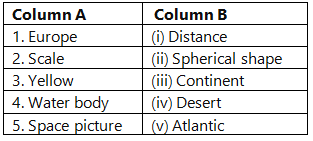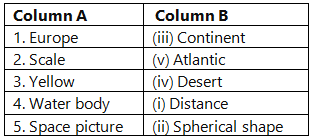Textbook Solutions: Map and Globe | Be an Explorer 5: Book Solutions, Notes & Worksheets - Class 5 PDF Download
Quick Zone
A. Tick (✓) the correct option to complete the sentence.
1. A globe cannot show_________.
(a) a part of the Earth
(b) 70% and 30% of the Earth
(c) the whole of the Earth
(d) behind the Earth
Ans: (c)
A globe is a three-dimensional representation of the Earth, and it can show the entire Earth's surface at once. Unlike maps, which are flat, globes don't have limitations in showing the Earth's complete shape and features.
2. The second largest continent is the ________.
(a) North America
(b) South America
(c) Asia
(d) Africa
Ans: (d)
Africa is the second largest continent in the world in terms of both land area and population. Asia is the largest continent.
3. The busiest ocean is the ________.
(a) Atlantic Ocean
(b) Indian Ocean
(c) Pacific Ocean
(d) Arctic Ocean
Ans: (a)
The Atlantic Ocean is one of the busiest oceans in the world due to its strategic location, extensive coastlines, and heavy maritime traffic, including shipping and trade routes.
4. The number of continents in the world is ________.
(a) 3
(b) 4
(c) 5
(d) 7
Ans: (d)
There are seven continents on Earth: Asia, Africa, North America, South America, Antarctica, Europe, and Australia.
5. The top of the map shows the ________ direction.
(a) South
(b) East
(c) West
(d) North
Ans: (d)
The top of a map typically points to the North direction, and it is usually marked as 'N.' The bottom of the map represents the South, while the right side is East, and the left side is West.
B. Fill in the blanks.
1. ______________ is the only planet that supports life.
Ans: Earth is the only planet that supports life.
2. Different _____ and ____ are used to give information on a map.
Ans: Symbols and signs are used to give information on a map.
3. _________ is an island continent.
Ans: Australia is an island continent.
4. ____________ colour is used for oceans, lakes and rivers.
Ans: Blue color is used for oceans, lakes, and rivers on a map.
5. __________ is the representation of the Earth on a flat surface.
Ans: A map is the representation of the Earth on a flat surface.
C. Write (T) for true statements and (F) for false statements.
1. Greenland is a continent. _____
Ans: F
Greenland is not a continent; it is a large island.
2. The Caspian Sea seperates Russia for Asia. _____
Ans: T
The Caspian Sea separates Russia from Asia.
3. All features on a map are shown in same colour. _____
Ans: F
Different features on a map are shown using various symbols and colors.
4. It is easier to carry a map than a globe. _____
Ans: T
Maps are easier to carry than globes.
5. An atlas is a book of maps. _____
Ans: T
An atlas is a book of maps.
D. Match the columns A and B.
 Ans:
Ans:
Writing Zone
Answer the following questions.
1. What do you mean by a scale of a map? What is meant by 1:100000?
Ans: A scale of a map is a ratio that represents the relationship between distances on a map and the actual distances on the Earth's surface. It helps in understanding the size and relative distances between different features on the map. For example, a scale of 1:100,000 means that 1 unit of measurement on the map represents 100,000 of the same units in the actual world. So, if 1 cm on the map equals 100,000 cm (or 1 km) in reality.
2. Differentiate between a globe and a map.
Ans: A globe is a three-dimensional model of the Earth that represents the planet's actual shape and size. It can show the entire Earth's surface without distortion. A map, on the other hand, is a two-dimensional representation of the Earth's surface on a flat piece of paper or other materials. Maps can be distorted to some degree due to the flattening process and may not represent the Earth's shape accurately.
3. What is called the language of a map?
Ans: The signs, symbols, and scale on a map are collectively referred to as the "language of a map." These elements convey information about geographical features, distances, and various symbols that help map readers understand the terrain and locations represented on the map.
4. How do colours represent different landforms on a map?
Ans: Colors are used to represent different landforms on a map by providing visual cues. For example:
- Blue is commonly used to depict water bodies such as oceans, seas, lakes, and rivers. Dark blue often indicates deep water, while light blue represents shallow water.
- Brown or shades of brown are used to represent mountains and plateaus. High mountains may be shown in dark brown, while low mountains and plateaus are in light brown. Snow-capped mountains can be represented using white.
- Green is often used for plains and lowlands.
- Yellow can be used to depict deserts or dry areas.
The use of colors and color variations helps map readers quickly identify and understand the different types of landforms on the map.
5. Name the three types of maps.
Ans: The three main types of maps are:
- Physical Maps: These maps focus on the physical features of the Earth's surface, such as mountains, plateaus, deserts, plains, rivers, and other natural landforms. They use different colors and symbols to represent these features.
- Political Maps: Political maps show political divisions of the world, including countries, states, districts, and other administrative boundaries. They help us understand the political organization of regions and countries.
- Thematic Maps: Thematic maps focus on specific information or themes, such as rainfall, population, roads, railways, minerals, crops, and more. They are designed to provide detailed information about a particular topic or subject on a geographic basis.




















